International Day of Yoga – a day for mental and physical well-being!
A day for mental and physical well-being known as International Day of Yoga (Yoga Day), is celebrated every year on 21 June since its commencement in 2015. An international day for yoga was declared unanimously by the United Nations General Assembly (UNGA). Ancient Yoga is a physical, mental and spiritual practice originated in India. The Indian Prime Minister Narendra Modi in his UN address recommended the date of 21 June, as it is the longest day of the year in the Northern Hemisphere and shares a special significance in various parts of the world.
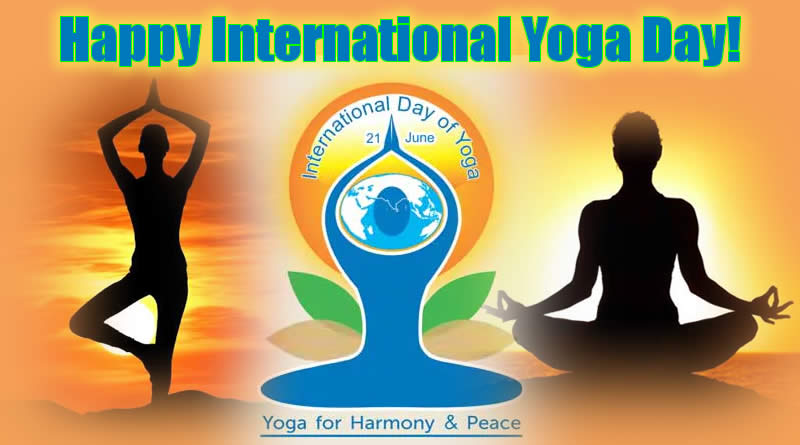
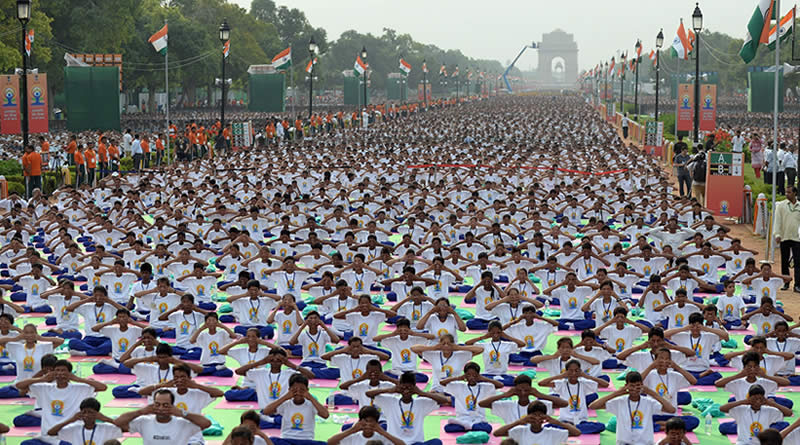
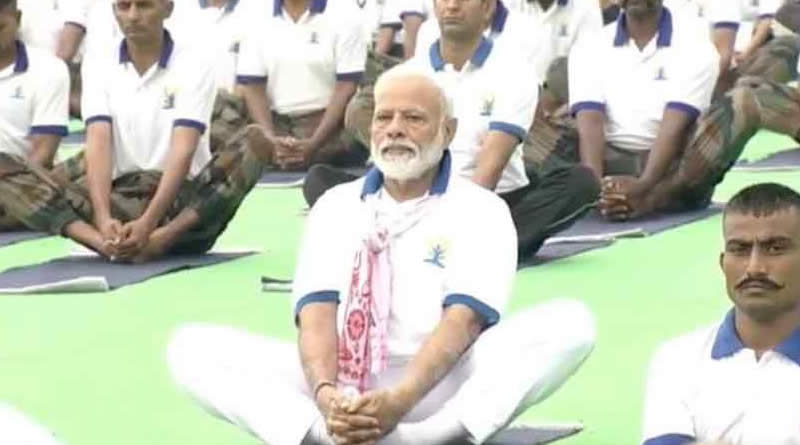
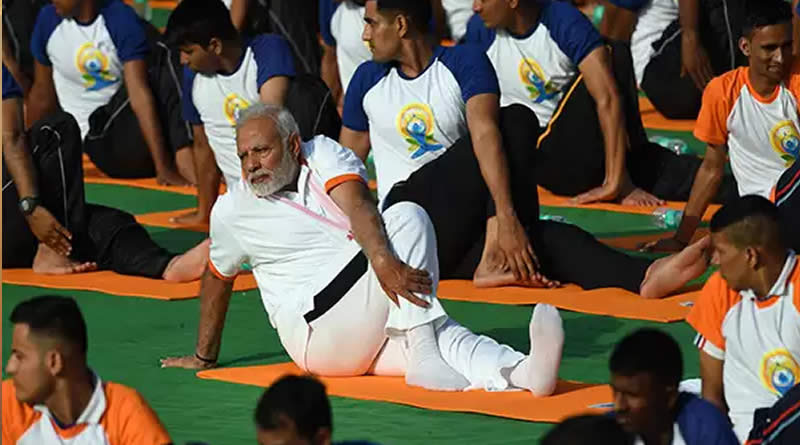
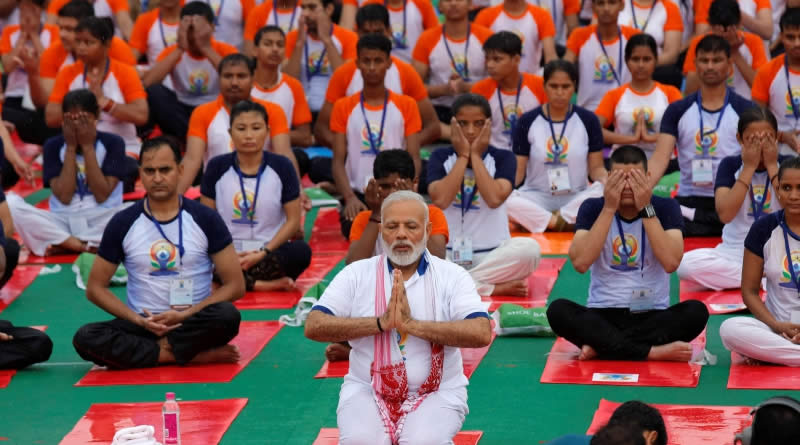
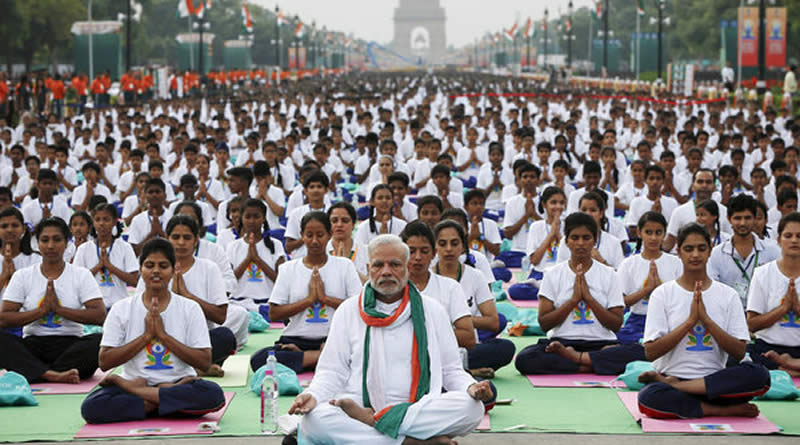
Origin of Yoga:
The concept of International Day of Yoga was first proposed by the current Prime Minister of India, Mr. Narendra Modi during his speech at the UNGA, on 27 September 2014. He stated as “Yoga is an invaluable gift of India’s ancient tradition. It embodies unity of mind and body; thought and action; restraint and fulfillment; harmony between man and nature; a holistic approach to health and well-being. It is not about exercise but to discover the sense of oneness with yourself, the world and the nature. By changing our lifestyle and creating consciousness, it can help in well-being. Let us work towards adopting an International Yoga Day.”
The origins of yoga are veiled in mystery and mythology while some historians find several clues in the practices of Himalayan Shamans as still be seen in Tibet and Nepal. The Lord Shiva is considered the father of ancient yoga while some historian claims that Patanjali is the father of modern yoga.
By the 5th century, BC yoga was becoming popular and begun to appear in Vedic Scripture. The word Yoga is a Sanskrit word and it comes from the root word Yuja which basically means to bind to align to hold. Earlier in 2015, Reserve Bank of India issued a 10 rupees commemorative coin to mark the International Day of Yoga.
History of Yoga:
India’s Permanent Representative Asoke Mukherji introduced the draft resolution in the United Nations General Assembly on 11 December 2014. The draft text received broad support from 177 Member States who sponsored the text, which was adopted without a vote. This initiative found support from numerous worldwide leaders. A total of 177 nations co-sponsored the resolution, which is the highest number of co-sponsors ever for any UNGA resolution of such nature.
When suggesting 21 June as the date, Modi told that the date was the longest day of the year in the northern hemisphere (shortest in the southern hemisphere), having special significance in numerous parts of the world. From the viewpoint of yoga, the summer solstice marks the transition to Dakshinayana. The second full moon after summer solstice is known as Guru Poornima. Shiva, the first yogi (Adi Yogi), is considered to have begun imparting the knowledge of yoga to the rest of mankind on this day, and became the first guru (Adi Guru). Dakshinayana is also considered a time when there is natural support for those pursuing spiritual practices.
Following the adoption of the UN resolution, numerous leaders of the spiritual movement in India voiced their support for the initiative. The founder of Isha Foundation, Sadhguru, specified, “this could be a kind of a foundation stone to make scientific approach to the inner well-being of the human being, a worldwide thing… It’s a tremendous step for the world.” The founder of Art of Living, Ravi Shankar, praised the efforts of Modi, telling, “It is very difficult for any philosophy, religion or culture to survive without state patronage. Yoga has existed so far almost like an orphan. Now, official recognition by the UN would further spread the benefit of yoga to the entire world.”
Events of Yoga in 2015:
The first International Day of Yoga was observed around the world on 21 June 2015. The Ministry of AYUSH made the needed arrangements in India. 35,985 people, including Narendra Modi and dignitaries from 84 nations, performed 21 asanas (yoga postures) for 35 minutes at Rajpath in New Delhi. The day was witnessed by millions across the world. NCC cadets entered the Limca Book of Records for the “largest yoga performance simultaneously by a single uniformed youth organisation” by performing at multiple venues.
The event at Rajpath established two Guinness world records awarded to the Ministry of AYUSH, and received by the minister Shripad Yesso Naik. They were for the largest yoga class, of 35,985 people, and for the largest number of participating nationalities (84 nations). In San Francisco, 5,000 participants gathered in the Marina Green park to practice yoga.
Events of Yoga in 2016:
The ministry prearranged an event titled “The National Event of Mass Yoga Demonstration” at Chandigarh, which was to be attended by the Indian Prime Minister.
Events of Yoga in 2017:
Indian prime minister Narendra Modi participated in the event and practiced yoga along with 51,000 participants in Lucknow. In New York, thousands of participants assembled to practice yoga on Times Square. Japan created a Parliamentary League for the promotion of yoga just prior to the event, in April 2017. In China, the largest gathering was 10,000 participants in the city of Wuxi. In Athens, the event took place on 25 June as part of the Greek Open Yoga Day and in Kyiv, the event happened on 18 June and gathered a few hundred participants. In Ireland, participants met in the round room of the City Hall in Dublin.
Events of Yoga in 2018:
The event was held at the Forest Research Institute in Dehradun. PM Modi led an estimated 50,000 volunteers to mark the fourth anniversary of International Yoga Day. The theme for 2018 was “Yoga for Peace”. Over 100,000 people assembled at a yoga session in Kota, Rajasthan and performed yoga together, earning the city a Guinness World Record.
Events of Yoga in 2019:
The main event is held in Ranchi and about 50,000 participants has participated in this mega event of Yoga day. The theme of the day is going to be “Yoga for climate change”.
Prime Minister Narendra Modi told at Ranchi that he “wanted to take make yoga an integral part of the lives of the poor” as he led around 30,000 people in performing asanas at a massive event in Jharkhand’s capital Ranchi to mark the fifth International Yoga Day celebrations.
PM Narendra Modi told, “Diseases make a poor person poorer; I want to take yoga from cities to the villages, to the jungles, to the poor and the adivasis (tribals),” PM Modi said, adding “Yoga belongs to everyone and everyone belongs to Yoga.” Home Minister Amit Shah, Defence Minister Rajnath Singh and other top ministers attended events in different parts of the country as part of Yoga Day celebrations. The theme of this Yoga Day is “climate action”.
“Let our motto be – Yoga for peace, harmony and progress,” PM Modi told yoga enthusiasts at the sprawling Prabhat Tara ground in Ranchi, urging people across the world to embrace yoga.
Events of Yoga in 2020:
Due to Corona pandemic, in 2020, the Yoga theme was Yoga for Health – Yoga at Home.
Events of Yoga in 2021:
In 2021, the Yoga theme was Yoga For Wellness.
Events of Yoga in 2022:
In 2022, the Yoga theme was Yoga for Humanity. Hon’ble PM Narendra Modi celebrated Yoga Day with other participants at Mysuru Palace Ground, Karnataka.
Events of Yoga in 2023:
In 2023, The theme for the International Day of Yoga 2023 is ‘Yoga for Vasudhaiva Kutumbakam’ or ‘Yoga for the Welfare of All as One World-One Family.’ International Day of Yoga is observed on June 21 every year. This day celebrates the ancient physical, mental and spiritual practice of yoga..
Surya Namaskar and how to do:
Famous Surya Namaskar is a practice in modern yoga combining a sequence of some twelve gracefully linked asanas. The asana sequence is first recorded in the early 20th century.
Surya Namaskar is a combination of sequence of around twelve asanas connected by jumping or stretching movements. In Iyengar Yoga, the basic sequence is Tadasana, Urdhva Hastasana, Uttanasana, Uttanasana with head up, Adho Mukha Svanasana, Urdhva Mukha Svanasana, Chaturanga Dandasana, and then reversing the sequence to return to Tadasana; other poses can be inserted into the sequence. In Ashtanga Vinyasa Yoga, the type 1 sequence is Tadasana, Urdhva Hastasana, Uttanasana, Anjaneyasana, Dandasana, Chaturanga Dandasana, Urdhva Mukha Svanasana, Adho Mukha Svanasana, Virabhadrasana I.
Surya Namaskar’s cycle as follows:
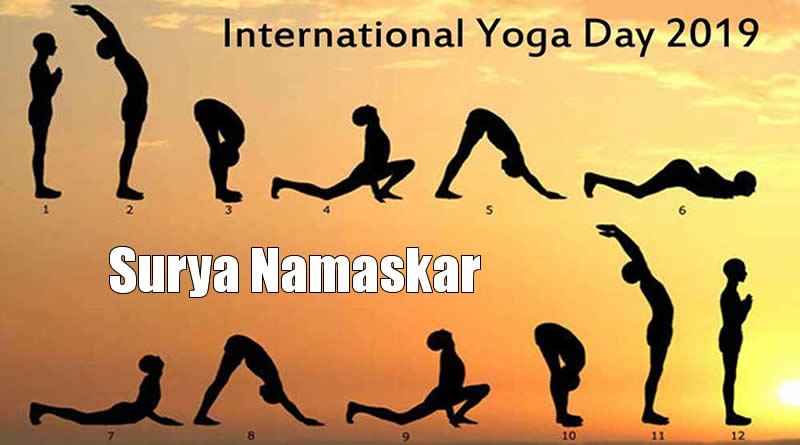
Step 1: Pranamasana (Prayer pose)
Follow the procedure as Stand at the edge of your mat, keep your feet together and balance your weight equally on both the feet. Expand your chest and relax your shoulders. As you breathe in, lift both arms up from the sides, and as you exhale, bring your palms together in front of the chest in prayer position.
Step 2: Hastauttanasana (Raised arms pose)
Follow the procedure as Breathing in, lift the arms up and back, keeping the biceps close to the ears. In this pose, the effort is to stretch the whole body up from the heels to the tips of the fingers.
Step 3: Hastapadasana (Standing forward bend)
Follow the procedure as Breathing out, bend forward from the waist keeping the spine erect. As you exhale completely, bring the hands down to the floor beside the feet.
Step 4: Ashwa Sanchalanasana (Equestrian pose)
Follow the procedure as Breathing in, push your right leg back, as far back as possible. Bring the right knee to the floor and look up.
Step 5: Dandasana (Stick pose)
Follow the procedure as As you breathe in, take the left leg back and bring the whole body in a straight line.
Step 6: Ashtanga Namaskara (Salute with eight parts or points)
Follow the procedure as Gently bring your knees down to the floor and exhale. Take the hips back slightly, slide forward, rest your chest and chin on the floor. Raise your posterior a little bit. The two hands, two feet, two knees, chest and chin (eight parts of the body) should touch the floor.
Step 7: Bhujangasana (Cobra pose)
Follow the procedure as Slide forward and raise the chest up into the Cobra pose. You may keep your elbows bent in this pose with the shoulders away from the ears. Look up at the ceiling.
Step 8: Adho Mukha Svanasana (Downward facing dog pose)
Follow the procedure as Breathing out, lift the hips and the tailbone up to bring the body into an inverted ‘V’ pose.
Step 9: Ashwa Sanchalanasana (Equestrian pose)
Follow the procedure as Breathing in, bring the right foot forward in between the two hands. The left knee goes down on the floor. Press the hips down and look up.
Step 10: Hastapadasana (Standing forward bend)
Follow the procedure as Breathing out, bring the left foot forward. Keep the palms on the floor. You may bend the knees, if necessary.
Step 11: Hastauttanasana (Raised arms pose)
Follow the procedure as Breathing in, roll the spine up. Raise the hands up and bend backward a little bit, pushing the hips slightly outward.
Step 12: Tadasana (Mountain pose)
Follow the procedure as As you exhale, first straighten the body, then bring the arms down. Relax in this position and observe the sensations in your body.
This completes one set of Surya Namaskar. Complete the round by repeating the steps.
Health benefits of Surya Namaskar:
1. Beneficial in controlling cardiovascular health
2. Encourages the nervous system wellness
3. Helpful for stretching, flexing and toning the muscles
4. First-rate exercise for weight loss management
5. Supports the immune system
6. Improves mental functions
7. Preserves overall health, strengthens the body and relaxes the mind
Note: It is essential to learn and practice yoga under the supervision of a trained Yoga teacher. In case of any medical condition, practice yoga only after consulting your doctor.



